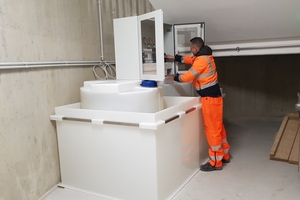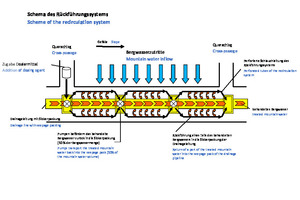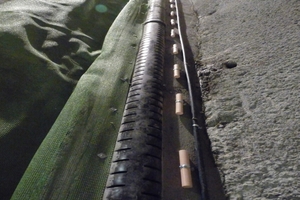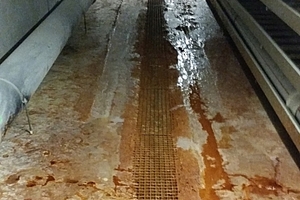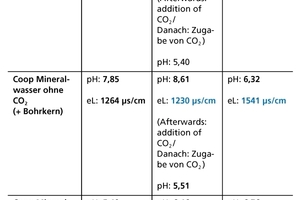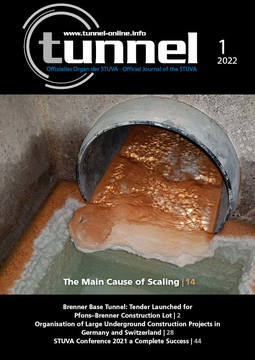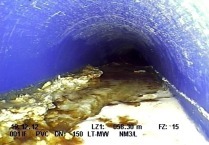The Main Cause of Scaling
Scaling in drainage systems has been a major problem for a long time. In the past decades, research in this field has focused on the construction materials used and the common construction techniques. Nevertheless, it is still not possible to make a precise statement about whether and to what extent a new tunnel will be affected by this. This has now changed, as it has been discovered that the most important aspect in the formation of scaling has not been taken into account so far – the CO2 content of the accumulating mountain water. We are not talking about CO2 concentrations as caused by acidic soils and/or precipitation, but CO2 concentrations that can only be explained by the influx of magmatic CO2 . Only zones with an influx of magmatic CO2 can cause scaling that leads to serious problems in practice.
Introduction
Scaling in drainage systems continues to be a problem worldwide. Despite great efforts in research and in practice, it is not yet possible to make a reliable statement about whether a planned tunnel will be confronted with this problem or not.
It may just be possible to make a prognosis based on water samples from neighbouring structures or test drillings in an area with highly calcareous mountain water, which would indicate that scaling is to be expected.
However, in an area where no water samples or existing structures can be used for consultation, it is almost impossible to make a reliable prognosis.
The reason for this lies in the fact that the most important factor that determines whether or not deposits will occur has remained unnoticed: it is the CO2 content of the mountain water that dominates the other influencing factors. We are not talking about CO2 concentrations such as those caused by acidic soils and/or precipitation, because these only cause minor scaling. We are talking about CO2 concentrations that can only be explained by the influx of magmatic CO2, and these can cause scaling that in practice leads to costly, serious problems.
It is the aim of this article to publicise this fact in order to redefine the future focus of research. With a reliable statement of the amount of mountain water to be expected, combined with its CO2 content, the most important project parameters could be determined. These include:
Design of the tunnel cross-section
Specification of the drainage system (dimension, distances, access possibilities, choice of material)
Quality of the lining (especially the shotcrete quality)
Measures for conditioning the mountain water (installation of a recirculation system, depot stones)
Decision on the use of construction measures that are unfavourable with regard to scaling, such as lean concrete, seepage concrete, recycled gravel, grouting, jetting, stabilisation of backfills and the like
 1 | Switzerland: Diversion ditch of the SBB Adlertunnel near Basel with massive deposits
1 | Switzerland: Diversion ditch of the SBB Adlertunnel near Basel with massive deposits
Credit/Quelle: Büro M.C. Wegmüller
State of Technology
Scaling is commonly understood to be the formation of deposits during the precipitation of minerals from flowing water. These deposits settle in drainage systems of underground structures (Fig. 1). Besides the main component lime, only a small percentage (1–5 %) of other minerals are contained in it.
In addition, in rare cases we see ochre deposits (iron ochre with a red colour), which do not harden and have a greasy consistency. They do not play a major role regarding the structure, but they do play a role in the identification of carbonic acid mountain waters, because as a rule only acidic waters are able to dissolve iron. So if you come across red deposits during the construction of a tunnel, in future this should set off an alarm bell.
A conventional method of removing deposits/scaling is high-pressure flushing with water (Fig. 2), in severe cases milling and/or chain-slinging of the affected parts of the drainage system with special tools (which, however, can cause heavy wear of the system parts).
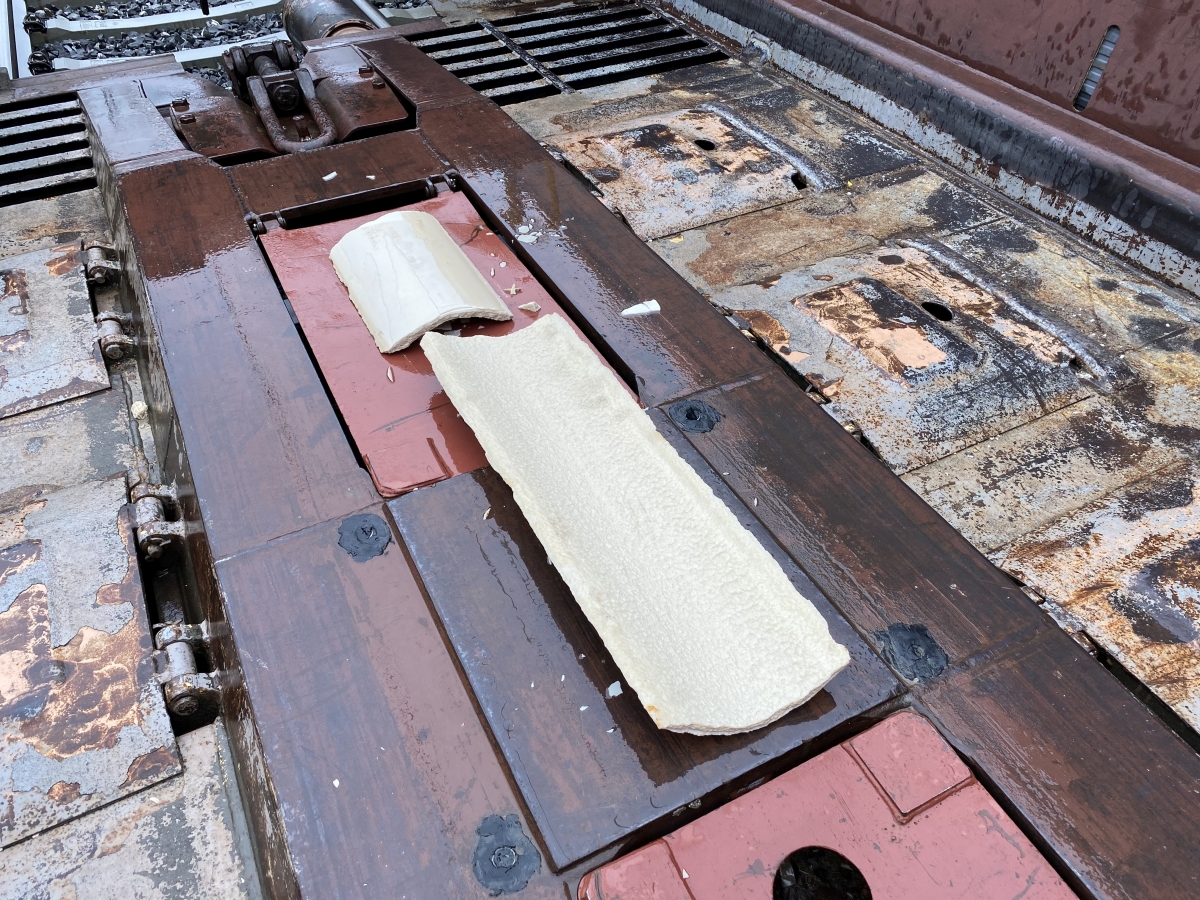 2 | This is where we reach the limits of conventional cleaning using high-pressure cleaning methods
2 | This is where we reach the limits of conventional cleaning using high-pressure cleaning methods
Credit/Quelle: Büro M.C. Wegmüller
On the planning side, we have various possibilities to minimise deposits and their effects. First and foremost, there is the installation of sufficient scaling voids [1], so that the mountain water has the opportunity to discharge the deposits outside the structure without blocking all inflow paths at the same time. When all flow paths are blocked in this way, water pressure builds up. This leads to increased corrosion of building materials, damage to the structure and loss of capacity of the tunnel due to the necessary maintenance work.
Other important measures to minimise deposits include avoiding lean concrete or permeable concrete of any kind – at least these should only be used very sparingly. The same applies to grouting, recycled concrete for fills/sub-bases, etc. that come into contact with mountain water. It is recommended to install drainage pipes with large openings (> 200 cm2/m), to refrain from using fleeces around the seepage packings (clogging of the seepage packing), to lay out flushable pipe sections, to choose particularly suitable shotcrete and concrete formulations etc.
Hardness Stabilisation
In recent years, various methods of hardness stabilisation (HS) have become established to prevent deposits. This is primarily the case in Switzerland, but increasingly also in Germany, Austria, France and Australia.
Liquid systems (Fig. 3): These transport the active ingredient in liquid form to the beginning of the section with the deposits. There, the active ingredient is added to the flowing mountain water. On the subsequent flow path, the active ingredient mixes with the mountain water and thus protects against new deposits.
 3 | Service work on a water hardness stabilisation plant. The storage tanks contain mineral salts for several years
3 | Service work on a water hardness stabilisation plant. The storage tanks contain mineral salts for several years
Credit/Quelle: Büro M.C. Wegmüller
Depot stones: Depot stones are the simplest form of hardness stabilisation. They consist of an active substance and a carrier material. When placed in the water, the active substance slowly dissolves and prevents the formation of hard limescale deposits. The carrier material remains and can be reused if necessary. They are suitable, for example, for low-volume drainage systems that do not always carry water. The best-known application, however, is in the seepage packs of drainage pipes in new construction projects. During the construction period (up to 5 years), they protect the external (primary) drainage system from blockages and thus keep the flow paths open.
 4 | Schematic of the recirculation system as installed for the AlpTransit structures
4 | Schematic of the recirculation system as installed for the AlpTransit structures
Credit/Quelle: Büro M.C. Wegmüller
Recirculation system: In this system, part of the previously conditioned mountain water (approx. 10%) is recirculated into the seepage packs of the drainage pipes using perforated hose lines (Figs. 4 + 5). There, it protects the seepage packing from deposits in the long term and thus prevents premature blockages. In this way, the drainage pipes remain functional for a long time and do not become clogged. The recirculation system can be seen as a reinsurance against premature blockages. It can also be operated partially, i.e. only in those sections where it is really necessary. If the formation of scaling is reduced, it can be deactivated again at any time.
 5 | Installation of the recirculation system (perforated hose lines), in combination with depot stones that prevent blockages during the construction period. Picture taken from the Ceneri Base Tunnel
5 | Installation of the recirculation system (perforated hose lines), in combination with depot stones that prevent blockages during the construction period. Picture taken from the Ceneri Base Tunnel
Credit/Quelle: Büro M.C. Wegmüller
Active Ingredients
Active ingredients suitable for hardness stabilisation (for depot stones of all sizes and shapes as well as liquid systems):
Fruit acids: Readily biodegradable without nitrogen or other undesirable compounds.
Salts: Mineral salts of sodium, magnesium or potassium are best suited to prevent deposits. 70% of the plants in Switzerland use mineral salts. All the environmental protection agencies consulted recommend the use of mineral salts.
Other active ingredients: All active ingredients containing phosphates or nitrogen, on the other hand, are unsuitable for hardness stabilisation and should no longer be used.
Research in Switzerland
The Regionalverkehr Bern-Solothurn AG (RBS) had ambitious goals for the new construction of its railway station in Bern, as they wanted to develop and use the optimum composition of the shotcrete formulation to be used. It is known that low alkalis, sparsely used admixtures and a concrete that is as dense as possible have positive effects on the scaling behaviour [2, 3, 4, 5]. Thus, six particularly promising mixtures were tested. These were a reference mix (medium quality), Vigier CT 180, Holcim Robusto with Sika, Juradur with BASF and two other formulations from BASF (on their own account). Among other things, the reduced scaling potential (RV) was tested in accordance with the öbv bulletin. All formulations met the requirements (0.7 kg/t) without problems; the reference mix was only just ok. The leaching rates were between 0.3 and 0.59 kg/t, with 0.71 kg/t for the reference mixture. The water used was distilled mountain water.
Test with Bernese Mountain Water
This test (RV) is always carried out with distilled water. The question now arises as to whether the scaling behaviour of these concrete mixtures changes with different types of mountain water – especially with the type of water (Bernese mountain water) that emerges in the existing neighbouring tunnel (Bern railway station) and causes significant deposits.
Thus, a new type of test was tackled, which consisted of placing drill cores of the six concrete mixtures mentioned above in containers made of PE and filling them with Bernese mountain water (Fig. 6). The containers were then left unchanged. The pH values, the electrical conductivity of the waters and the weight of the empty containers (including the newly forming deposits) were measured at regular intervals. In order to provoke deposits more quickly, the containers were left standing open so that deposits could form due to the continuous evaporation of water (salinisation).
 6 | Six different concrete samples in the containers with Bernese mountain water
6 | Six different concrete samples in the containers with Bernese mountain water
Credit/Quelle: Büro M.C. Wegmüller
It turned out that the mixtures of the drill cores with the mineral waters all caused no deposits on the walls of the containers despite 50% evaporation of the mountain water. A slimy surface formed on the inside walls of all containers – no trace of hard deposits (the weight of the slime layer was determined to be 10–80 mg per container). Only the Bernese mountain water that had been filled into the container without a drill core and evaporated had hard deposits on the walls afterwards (about 133 mg in the whole container). This means that Bernese mountain water does not cause deposits when it comes into contact with fresh concrete?! So where do the deposits from the existing tunnel originate from?
Our engineering office repeated this test, but this time used different types of water. It turned out that the three types of water without carbon dioxide (distilled water, Silence
from Valser, Coop without CO2) were only able to dissolve a few particles from the drill cores (0–40 mg/l per day). In contrast, the two waters with CO2 (Valser and Coop with CO2) dissolve 10 to 50 times more particles from the concrete already in the first day (300–500 mg/l per day).
The experiment was repeated again, but now CO2 was added to five mineral waters after one day. The measurement of the electrical conductivity of the waters showed that the addition of CO2 had multiplied the amount of dissolved substances in a single day (by a factor of up to 50). But the most astonishing thing was that lime deposits had now formed on all the container walls - within a week and without any significant evaporation of the mountain waters (Table 1).
 Table 1 | Leaching rates for different mineral waters with and without CO2 (blue letters = highest leaching). The measured values of electrical conductivity in μs/cm can be approximated as mg/l
Table 1 | Leaching rates for different mineral waters with and without CO2 (blue letters = highest leaching). The measured values of electrical conductivity in μs/cm can be approximated as mg/l
It seems that the fact whether a certain mountain water has CO2 plays a far greater role than the concrete quality that is used. It therefore does not play a decisive role whether the shotcrete formulation contains, for example, 1% more microsilica or not. As it is, nothing will happen without CO2. Only CO2 has the power to lower the pH value of the mountain water in such a way that it dissolves lime constituents from the rock and/or the concrete lining and deposits them again in the drainage system.
 7 | Distribution of acidulous water in Europe, by Walter Carlé (1976)
7 | Distribution of acidulous water in Europe, by Walter Carlé (1976)
Credit/Quelle: (1)
Transferring These Results Into Practice
Now it might be clear why we have much more problems with scaling in some regions of Europe than in others. If we compare Walter Carlé’s mineral water map with the acidulous regions of Europe (Fig. 7, [1]), some regions catch our eye. In Switzerland, these are the Valais and the canton of Graubünden, which have a large number of acidulous water bodies and very heavy deposits (mostly red in colour) in many tunnel structures (Fig. 8). But even in such regions, individual structures can be massively affected by deposits while others in the immediate vicinity show no problems at all. This can be explained by the inflow of CO2-containing mountain water from underground. Only where these inflows are driven up do we see massive deposits. These deposits (usually > 2 mm–20 cm in thickness per year) cannot be compared with deposits caused by CO2 enrichment in the soil air (< 2 mm in thickness per year).
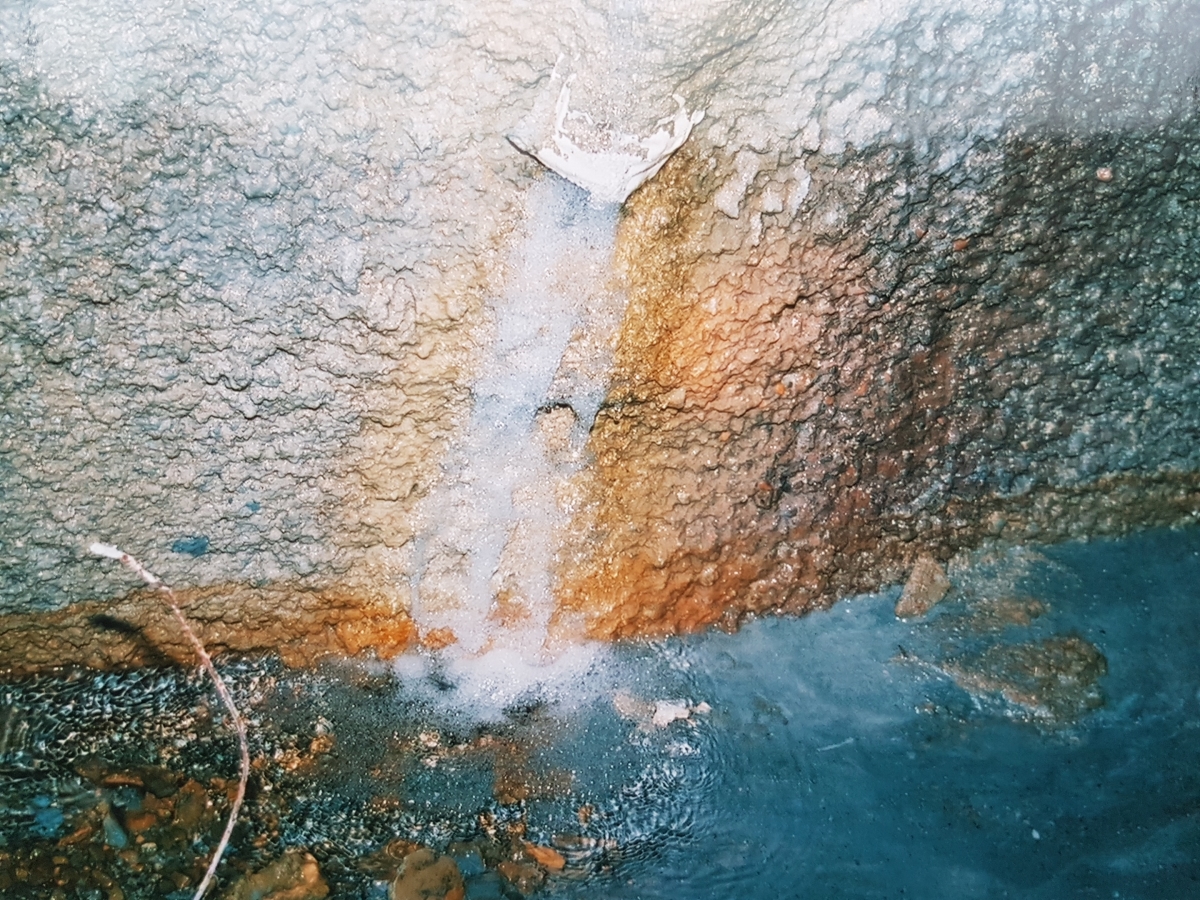 8 | Entry of carbonic acid mountain water into the Gotschna Tunnel in the canton of Graubünden. The escape of the CO2 causes bubbles to form. Such water ingress is an alarm signal for the highest danger of scaling
8 | Entry of carbonic acid mountain water into the Gotschna Tunnel in the canton of Graubünden. The escape of the CO2 causes bubbles to form. Such water ingress is an alarm signal for the highest danger of scaling
Credit/Quelle: Büro M.C. Wegmüller
If we observe the location of the new Hannover-Würzburg railway line in Germany, it runs right through the longest and most massive area of acidulous water bodies in the whole of Central Europe. It now seems obvious why, for example, a Mühlberg Tunnel at the end of the 1990s had cleaning costs of around DM 1 million (= 200 flushing nights per year) and why the DB AG only wanted to build pressure-water-retaining tunnel structures for the future.
In certain regions, the occurrence of these waters is
predictable, such as in the region around the Engandin Window or the Tauern Window. In other regions, such as the Swiss Plateau, we are surprised to encounter mountain water containing CO2.
 9 | Bridge between the Visp and Eyholz tunnels of the A9 in the canton of Valais
9 | Bridge between the Visp and Eyholz tunnels of the A9 in the canton of Valais
Credit/Quelle: Büro M.C. Wegmüller
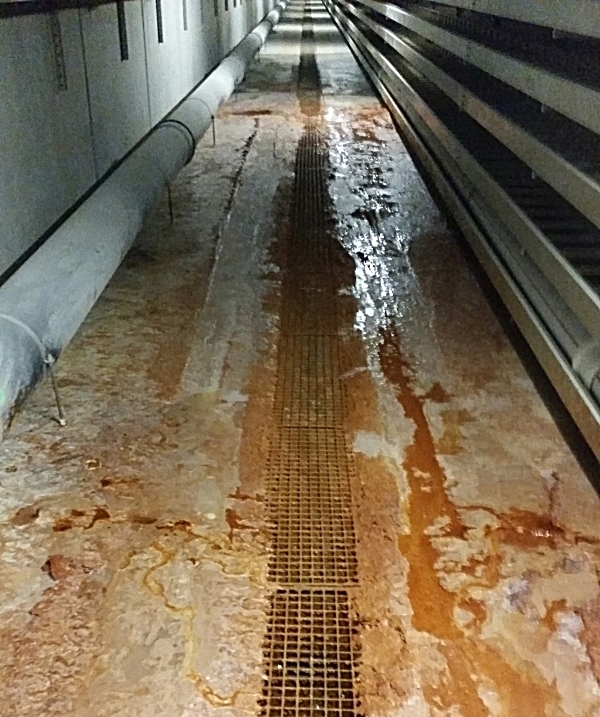 10 | Deposits in the service duct of the Eyholz Tunnel
10 | Deposits in the service duct of the Eyholz Tunnel
Credit/Quelle: Büro M.C. Wegmüller
On-Site Verification
To substantiate all these claims, we set out to visit the tunnel currently worst affected by sedimentation in Switzerland. It is the Eyholz tunnel of the A9 in the Valais (Fig. 9). Here we encountered massive deposits in the service ducts of both tunnel tubes (Fig. 10). In order to be able to detect the CO2 content in the mountain water, we were equipped with a pH meter, an electrical conductivity meter and a CO2 gas meter (Fig. 11). We examined the entire length of both service ducts. The diagram in Figure 12 shows the most important results.
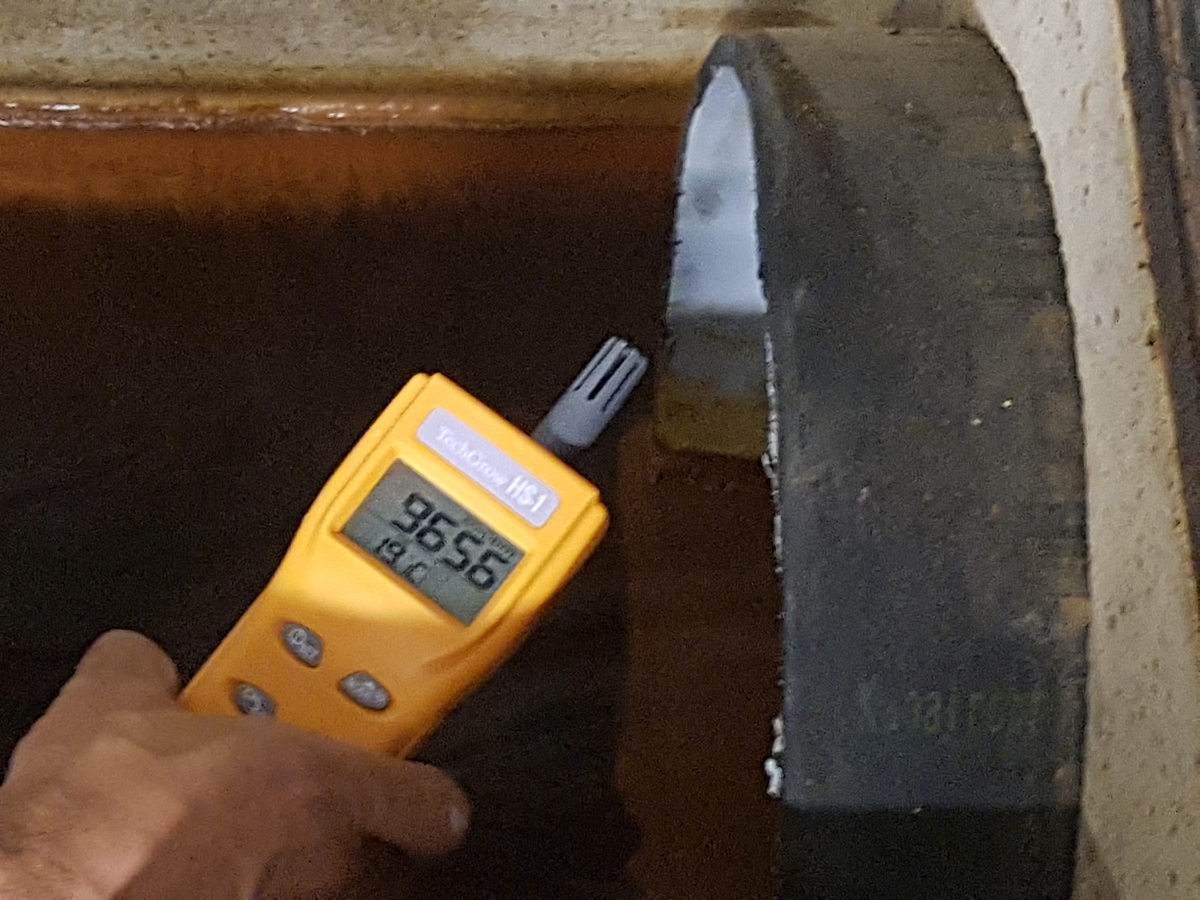 11 | CO2 concentration in the piping
11 | CO2 concentration in the piping
Credit/Quelle: Büro M.C. Wegmüller
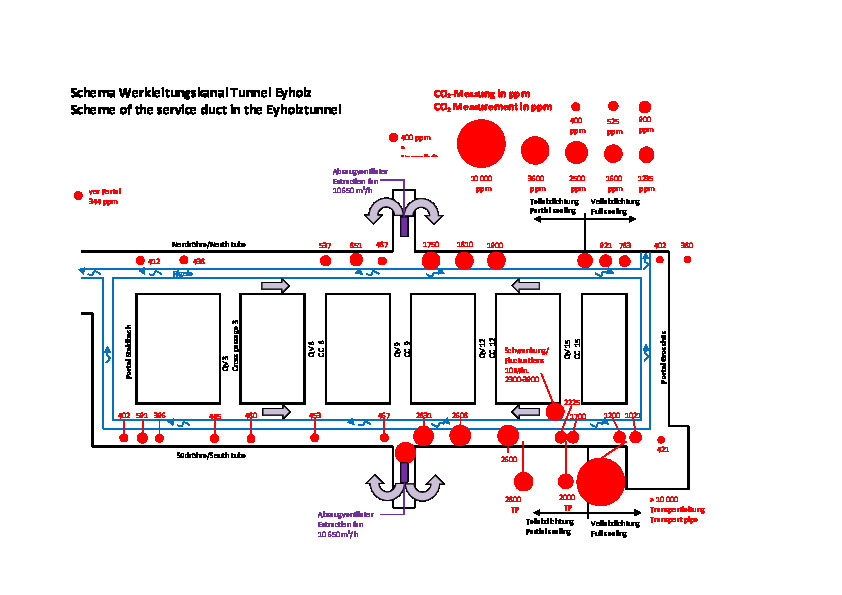 12 | Schematic of the service duct of the Eyholz tunnel with the measured CO2 levels
12 | Schematic of the service duct of the Eyholz tunnel with the measured CO2 levels
Credit/Quelle: Büro M.C. Wegmüller
The CO2 content in the atmosphere is currently approx. 420 ppm (1 ppm = 1.9888 mg/m3). Starting from the Staldbach portal, we encounter almost normal values in the south tube up to the middle of the tunnel. After that, however, the concentration of CO2 rises to 3000 ppm and more. This is the case with continuous ventilation and extraction of the air (via two extraction fans in the middle of the service ducts), which each extract around 10 650 m3 of air per hour from both service ducts and transport it away into the traffic area. In contrast, the concentration of CO2 in the traffic area is almost unpolluted at around 500 ppm. The zones with the CO2 increase coincide with the zones with the heaviest deposits. This can be seen most clearly at the Grosshüs portal. Here, a full sealing was installed around both tunnels for the last 550 m. The mountain water degasses here (change in gradient) to such an extent over the last 500 metres that the pH value of the infiltration trench water (15 l/s) rises from 6.7 to 8. At the same time, the CO2 concentration in the ambient air drops from 2000 ppm to 421 ppm (atmospheric level). The sediments here, in the drainage system‘s infiltration trench, reach 3–4 cm per year and are as hard as rock.
Around 500–1000 tonnes of magmatic CO2 escape from the two service ducts per year. On this stretch, this corresponds to a traffic load of around 5000 vehicles per day. The CO2 not only escapes from the mountain water, but also diffuses through the concrete lining (cracks and joints) into the interior of the two service ducts. As a result, there are points in the service ducts that show fluctuations in the CO2 concentrations (from 2000 to 4000 ppm within 10 minutes) and so far these can only be explained by alternating gas influxes. It is a stroke of luck that this tunnel has strong ventilation in both service ducts, which makes it possible to determine the actual CO2 concentrations. There is no way of knowing how much CO2 escapes from this mountain alone per year.
Releases of Magmatic CO2 on an Unexpected Scale
If we assume that this is not a singular phenomenon, we can imagine how large the quantities of CO2 must be that have entered the atmosphere in this way practically unnoticed up to now. Magmatic CO2 is well-known, but the distribution and scale at which it can occur is new, and this is of crucial importance, especially for a tunnel drainage system. If we add up all the CO2 emissions from the subsurface that enter the atmosphere worldwide, this could add up to a contribution that has been left out of the climate models.
We have subsequently investigated a number of other tunnels. The measured CO2 concentrations coincide with the existing deposits in 95% of the cases. In the remaining cases, the measurement conditions (too little water, concrete carbonisation, etc.) could also have played a role. The measured values are listed in Table 2.
 Table 2 | CO2 measurements of other tunnel structures
Table 2 | CO2 measurements of other tunnel structures
The investigations so far have shown that a CO2 content of up to 600 ppm in the shafts of a drainage system means rather moderate deposits. Between 600 and 2000 ppm we expect moderate to heavy deposition. Above 2000 ppm we face only heavy deposition. Values above 10 000 ppm make flushing measures necessary at intervals of no more than three months.
Conclusion
Previous investigations in this field were almost exclusively concerned with the quality of the construction materials used. These studies were certainly not wrong, but they overlooked the most important aspect – the natural influx of magmatic CO2 from the underground.
This mechanism has nothing to do with the accumulation of CO2 in rainwater in the uppermost layers of the earth - much lower concentrations occur there, and the depositions caused by this are minor and short-term in nature. Here we are talking about CO2 influxes from the interior of the Earth. Investigations to date show that around 10–20% of all tunnel structures in Switzerland are affected by this. In all cases, this leads to massive deposits. Research in the field of drainage systems/scaling must devote more attention to this aspect in the future.
A CO2 forecast should be fundamental for future underground constructions. The forecast must be adjusted and documented during the construction period. It can significantly influence the decision on the design of the cross-section, the choice of materials and the construction methods. It also provides the basis for the maintenance of the future drainage system.
Tunnel projects under construction could be adjusted if necessary on the basis of the newly gained knowledge, and danger zones can be localised (Brenner Base Tunnel – Tauern Window). Of course, it would also make sense to examine rehabilitation projects in advance with regard to the CO2 situation.
Tunnel projects for which a lot has been invested in hardness stabilisation procedures could be reviewed with regard to their scope and expediency by directly examining the CO2 situation on site (Koralm Tunnel, recirculation system).
If you encounter acidic mountain water in magmatic rocks without lime content (e.g. granite), you must use a high quality of concrete for your tunnel, because the mountain water will leach out the concrete. These
deposits are white and slowly recede over the years. If you encounter acidic mountain water in rocks with lime, a normal concrete quality is sufficient, because the mountain water will only leach your concrete very slightly as it is already completely saturated with lime. These deposits are coloured and will not recede over the years.
More in-depth CO2 measurements must be taken, which should also include, for example, areas with high radon levels and/or areas with karstic geology. It should then be possible to estimate how much CO2 is constantly escaping from the underground worldwide. This amount will certainly be much greater than previously assumed and could influence the calculation of climate models. It is not only volcanoes that emit CO2. It would also make sense to think about how the influx of CO2 in the oceans works – for example, whether gas bubbles can be observed or whether the accumulation is already taking place in the bedrock and is therefore not visible.



